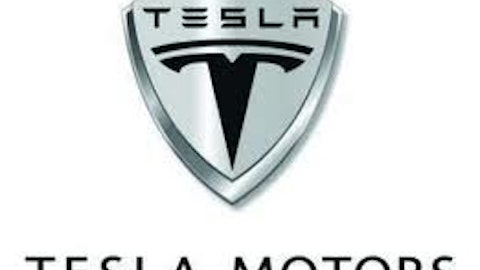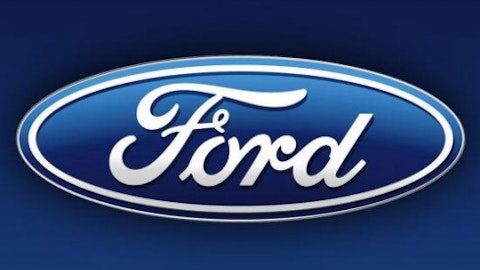If electric vehicles have a reputation for anything, it’s that they’re better for the environment than their gas counterparts and they’ll save you money on gas. However, while it’s true that EVs are generally better for the environment than say, a truck, when you factor in variables like a battery’s carbon debt, and what goes into charging that battery, the “better for the environment” part goes right out the window. That’s especially true for Tesla Motors Inc (NASDAQ:TSLA)‘ Model S — and it’s a reality that may come back to bite it.

Photo: Tesla Motors, via Wikimedia Commons.
Sorry, not polar-bear friendly
According to Climate Central, when cars are manufactured, gas-powered vehicles are initially better for the environment than EVs, because when the battery that powers EVs is manufactured, it creates a 10,000- to 40,000-pound carbon debt, which can be overcome only by charging the car on green energy and driving it for tens to hundreds of thousands of miles.
Complicating the matter is that different states generate power from different energy sources. For example, West Virginia gets a majority of its electricity generation from coal, while Vermont relies on nuclear, Idaho uses hydropower, and Rhode Island consumes natural gas. As a result, EVs’ CO2 emissions vary depending on what energy source charges their batteries. And for the first 50,000 miles of an EV’s life, when it comes to CO2 emissions, in 39 states it’s actually better to drive a gas-powered hybrid, such as Toyota Motor Corporation (ADR) (NYSE:TM)‘s Prius, than it is to drive the least-polluting EV.
For luxury sedans, the numbers escalate. In 46 states, it’s better for the climate to drive one of Toyota Motor Corporation (ADR) (NYSE:TM)’s Lexus ES hybrids for the first 100,000 miles than it is to drive Tesla Motors Inc (NASDAQ:TSLA)’s Model S.
In fact, of all the EVs available, the Model S is the least climate-friendly EV, and it’s worse than all but two hybrids when it comes to CO2 emissions and 100,000 miles of driving. And before you blame coal, keep in mind that only 13 states get a majority of their electricity generation from coal.
The reality of CO2 lifecycle emissions
Taking into account that each state generates electricity from different sources, Climate Central combined vehicle manufacturing emissions with an average mix of electricity to evaluate the lifecycle emissions of every EV and hybrid available, for its report “A Roadmap to Climate-Friendly Cars: 2013.” The study found that hybrids — like the Prius — have lower overall CO2 emissions than all-electric vehicles. In fact, the Prius and Prius Plug-In ranked first in every state as the most CO2-friendly. The Prius hybrid’s pounds per CO2 equivalent per mile is 0.67, and the Prius Plug-In’s is 0.64, based on 100,000 miles of driving.
That’s in comparison with the 60 kilowatt-hour Tesla Motors Inc (NASDAQ:TSLA) Model S, whose pounds per CO2 equivalent per mile is 1.14; and the 85 kWh Tesla S, which comes in at 1.34, also based on 100,000 miles of driving.
Why this should matter
When driving emissions are calculated without manufacturing emissions, many EVs are better for the climate in states that rely on green energy. However, when manufacturing emissions are included — and they must be to factor in overall climate impact — EVs are not as environmentally friendly as some would have you believe. As Climate Central states: “In many states the rapid substitution of coal with natural gas and the adoption of substantial amounts of wind power have measurably decarbonized the grid from 2010 to 2012. These changes have shifted the balance of carbon emissions in favor of recharging electrics vs. burning gasoline in high-mileage hybrids like the Prius, if car manufacturing emissions are excluded.“ (Emphasis mine.)
In other words, even when EVs are powered by green energy, they’re not necessarily the most climate-friendly option — and that’s in large part because of the battery.
That raises two big concerns. First, batteries, by their nature, lose charge over time — it’s unavoidable. Eventually, you’ll have to replace the battery or buy a new car. Second, as I’ve written before, lithium is an alkali metal and isn’t naturally occurring. It has to be refined after being extracted through salar brines (the most common approach) and mined hard rock. More pointedly, a study by the European Commission on Science for Environmental Policy states: “Although there is no immediate shortage of lithium, its continued use needs to be monitored, especially as lithium mining’s toxicity and location in places of natural beauty can cause significant environmental, health, and social impacts.”
To put it succinctly, what this all should mean is that the push toward all-electric cars needs to be re-evaluated by including lifecycle emissions, and not just “well-to-wheels” emissions.
What it actually means
Because the Environmental Protection Agency is pushing for the reduction of greenhouse gas emissions and has put in place new regulations, car manufacturers are pursuing ways to make their vehicles more “green.” However, when people make an argument for the environmental benefits of EVs, they’re probably unaware of overall lifecycle emissions. There’s also a great deal of money being invested in battery-powered cars — both by the government, and by vehicle manufacturers. Consequently, EVs will probably enjoy growing success — until science bites back.
For Tesla Motors Inc (NASDAQ:TSLA)’s Model S, this could be a problem. Right now, the Model S is winning accolades and standing ovations for being a brilliant EV. And it is. Make no mistake about it. But the fact remains that it’s worse for the climate than every other EV, and all but two hybrids.
What to watch
Tesla Motors Inc (NASDAQ:TSLA)’s current valuation is based in large part on the idea that it’s the carmaker of the future and that eventually it’ll make an EV that the masses can afford. That idea, in turn, is based on the idea that the masses will want an EV. Those are some big ifs, especially given that EVs rely on batteries that generate a huge carbon debt, rendering them anything but polar bear-friendly.
Yes, Tesla makes a beautiful car, but is the Model S the “green” car of the future? Frankly, I don’t think so. There are better alternative-energy solutions than batteries — which I’ll address in my next article.
The article Is Tesla’s Model S Bad for the Environment? originally appeared on Fool.com and is written by Katie Spence.
Fool contributor Katie Spence has no position in any stocks mentioned. Follow her on Twitter: @TMFKSpence. The Motley Fool recommends and owns shares of Tesla Motors.
Copyright © 1995 – 2013 The Motley Fool, LLC. All rights reserved. The Motley Fool has a disclosure policy.



